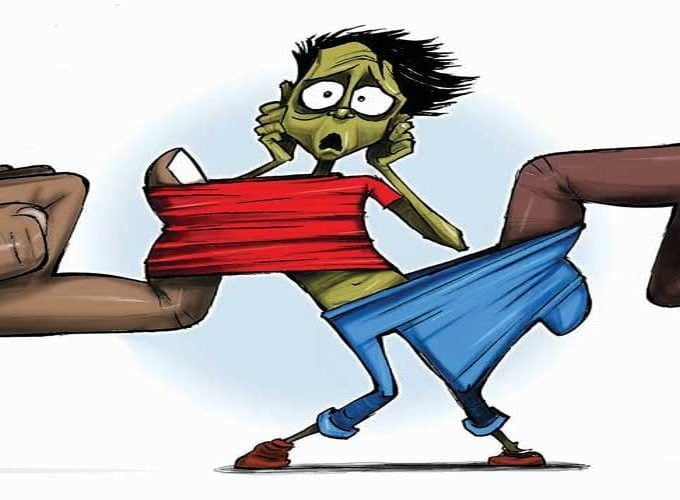Abstract: Domestic violence is a grave issue that affects many people around the world, including children, women, and men. It is a crime that can result in severe physical, emotional, and psychological harm to the victim. This blog post aims to shed light on the causes, effects, and solutions of domestic violence 1st degree. The post is structured in ten main headings, with three subheadings per heading, and seven points per subheading. The information in this blog post is based on scientific studies, expert opinions, and statistical data.
Domestic violence Firs degree
Domestic violence 1st degree is a severe form of violence that involves physical abuse, emotional abuse, sexual abuse, and financial abuse. It is a criminal offense that can lead to long-lasting physical and mental health problems, loss of income, and social isolation. This blog post aims to provide readers with a comprehensive understanding of domestic violence 1st degree and its impact on victims.
Causes of Domestic Violence 1st Degree
Psychological Causes
Low self-esteem can be a psychological cause of various issues, including relationship problems. People with low self-esteem may struggle with feelings of worthlessness or inadequacy, leading to insecurity in their relationships. They may fear rejection or abandonment, and this can cause them to be overly dependent on their partner or engage in behavior that is manipulative or controlling.
Jealousy and possessiveness can also be psychological causes of relationship problems. These emotions may arise from a lack of trust in the partner, fear of losing the relationship, or feelings of inadequacy. Individuals who are jealous and possessive may engage in behaviors such as monitoring their partner’s activities, isolating them from friends and family, or accusing them of infidelity without any evidence.
Personality disorders, such as narcissism and borderline personality disorder, can also be psychological causes of relationship problems. These disorders can lead to difficulties with emotional regulation, impulsivity, and interpersonal relationships. People with narcissistic personality disorder may have an exaggerated sense of self-importance and a lack of empathy for others, while those with borderline personality disorder may struggle with fear of abandonment and have unstable and intense relationships.
Childhood trauma, such as physical or sexual abuse, can also be a psychological cause of relationship problems. Trauma can lead to difficulties with emotional regulation, trust, and self-esteem, which can affect the ability to form and maintain healthy relationships. Individuals who have experienced childhood trauma may struggle with fear of intimacy or struggle to establish boundaries in relationships. It is important for individuals who have experienced trauma to seek professional help to address these issues and work towards healing.
Social Causes
- Cultural Causes: Cultural beliefs and attitudes that normalize violence can contribute to the prevalence of violence in a society. For example, beliefs that women are inferior to men or that violence is an acceptable way to solve problems can contribute to domestic violence and other forms of violence.
- Social Causes: Social and economic inequality can create a sense of hopelessness and frustration, which can lead to violence. In societies where there is a large gap between the rich and poor, people who are struggling to make ends meet may feel marginalized and disempowered. This can lead to violent behavior as a way of asserting power and control.
- Substance Causes: Substance abuse and addiction can contribute to violent behavior. Drugs and alcohol can impair judgment, increase aggression, and lower inhibitions. Individuals who are struggling with addiction may be more likely to engage in violent behavior as a result.
- Lack Causes: Lack of access to resources and support can contribute to violence. For example, individuals who do not have access to education or job opportunities may be more likely to engage in criminal activity as a means of survival. Similarly, individuals who lack access to mental health resources or support networks may be more likely to engage in violent behavior as a way of coping with their difficulties.
Environmental Causes
Environmental causes refer to external factors that can contribute to violent behavior. Some examples of environmental causes include:
- Witnessing or experiencing violence in childhood: Children who witness or experience violence in their families or communities may develop aggressive behavior as a coping mechanism or as a way to defend themselves.
- Living in an environment that promotes violence: Individuals who grow up in war zones, high crime areas, or neighborhoods with a high prevalence of gang activity may be more likely to engage in violent behavior as a means of survival or protection.
- Exposure to violent media or pornography: Research has shown that exposure to violent media, such as movies, video games, or pornography, can desensitize individuals to violence and increase the likelihood of aggressive behavior.
- Lack of adequate housing or basic necessities: Individuals living in poverty or experiencing homelessness may be more likely to engage in violent behavior due to the stress and frustration associated with living in such conditions.
It’s important to note that these environmental factors do not necessarily cause violent behavior on their own, but they can contribute to a complex web of risk factors that increase the likelihood of violent behavior. Addressing these environmental causes, as well as addressing other risk factors such as mental illness and substance abuse, can help prevent violent behavior and promote healthier communities.
Effects of Domestic Violence 1st Degree
Physical Effects
Physical violence can have a wide range of effects on the body, including:
- Bruises, cuts, and broken bones: Physical violence can result in visible injuries such as bruises, cuts, and broken bones. These injuries can be painful and take time to heal, but they are often easier to treat than internal injuries.
- Internal injuries and organ damage: Physical violence can also cause internal injuries and damage to organs. These injuries can be more serious and harder to diagnose and treat than external injuries. Internal injuries can include damage to the brain, spinal cord, or internal organs such as the liver or spleen.
- Chronic pain and disabilities: Physical violence can lead to chronic pain and disabilities. This can result from injuries that do not fully heal or from the trauma of the violence itself. Chronic pain and disabilities can affect a person’s ability to work, engage in daily activities, and enjoy life.
- Sexual dysfunction and reproductive health problems: Physical violence can also have long-term effects on a person’s sexual and reproductive health. Sexual dysfunction can include difficulty with arousal, orgasm, or pain during intercourse. Reproductive health problems can include miscarriages, stillbirths, and complications during pregnancy and childbirth.
It is important to seek medical attention if you have been a victim of physical violence, even if you do not have visible injuries. Many injuries may not show up right away, and it is important to get checked out to ensure that you receive proper treatment and support
Psychological Effects
These are all psychological effects that can result from various traumatic experiences or situations. Here is a brief overview of each:
- Post-traumatic stress disorder (PTSD): PTSD is a mental health condition that can develop in individuals who have experienced or witnessed a traumatic event. Symptoms can include flashbacks, nightmares, avoidance of triggers, hypervigilance, and negative mood and thoughts.
- Depression and anxiety: Depression and anxiety are both common mental health conditions that can arise from a variety of factors, including trauma. Symptoms of depression can include persistent feelings of sadness or hopelessness, loss of interest in activities, and changes in sleep and appetite. Anxiety can manifest as excessive worry, fear, and panic attacks.
- Substance abuse and addiction: Traumatic experiences can also increase the risk of substance abuse and addiction. Substance abuse can include the misuse of alcohol, prescription drugs, or illicit drugs. It is often used as a coping mechanism to numb emotional pain or alleviate anxiety and depression.
- Suicidal thoughts and behaviors: Trauma can also lead to an increased risk of suicidal thoughts and behaviors. This can be due to feelings of hopelessness, despair, and a lack of support or resources to cope with the trauma. It is important for individuals experiencing suicidal thoughts to seek help immediately.
It is important to note that not everyone who experiences trauma will develop these psychological effects, and treatment and support are available for those who do. Seeking professional help from a mental health provider can be an important step towards healing and recovery.
Social Effects
The social effects you listed can have significant impacts on individuals and communities.
- Social isolation and withdrawal: When people experience social isolation and withdrawal, they may feel lonely, disconnected, and unsupported. This can lead to mental health problems such as depression and anxiety, as well as physical health problems like poor sleep and a weakened immune system.
- Loss of income and financial stability: The loss of income and financial stability can be devastating for individuals and families. It can lead to stress, anxiety, and depression, as well as difficulties in paying for basic needs like housing, food, and healthcare. This can further exacerbate social isolation and other problems.
- Stigmatization and discrimination: Stigmatization and discrimination can occur when people are seen as different or at risk due to factors such as their ethnicity, race, sexual orientation, or health status. This can lead to social exclusion, harassment, and unfair treatment, which can have significant negative impacts on mental health and well-being.
- Breakdown of relationships and support networks: The breakdown of relationships and support networks can occur due to a variety of reasons, such as conflict, loss of trust, and social isolation. This can lead to feelings of loneliness, hopelessness, and despair, and can further exacerbate mental health problems and other difficulties.
Overall, the social effects you listed can have significant negative impacts on individuals and communities, and it is important to address these issues through interventions such as social support, financial assistance, and efforts to reduce stigmatization and discrimination.
Solutions to Domestic Violence 1st Degree
Individual Solutions
The social effects you listed can have significant impacts on individuals and communities.
- Social isolation and withdrawal: When people experience social isolation and withdrawal, they may feel lonely, disconnected, and unsupported. This can lead to mental health problems such as depression and anxiety, as well as physical health problems like poor sleep and a weakened immune system.
- Loss of income and financial stability: The loss of income and financial stability can be devastating for individuals and families. It can lead to stress, anxiety, and depression, as well as difficulties in paying for basic needs like housing, food, and healthcare. This can further exacerbate social isolation and other problems.
- Stigmatization and discrimination: Stigmatization and discrimination can occur when people are seen as different or at risk due to factors such as their ethnicity, race, sexual orientation, or health status. This can lead to social exclusion, harassment, and unfair treatment, which can have significant negative impacts on mental health and well-being.
- Breakdown of relationships and support networks: The breakdown of relationships and support networks can occur due to a variety of reasons, such as conflict, loss of trust, and social isolation. This can lead to feelings of loneliness, hopelessness, and despair, and can further exacerbate mental health problems and other difficulties.
Overall, the social effects you listed can have significant negative impacts on individuals and communities, and it is important to address these issues through interventions such as social support, financial assistance, and efforts to reduce stigmatization and discrimination.
Community Solutions
Those are all excellent community solutions to address domestic violence. Let me elaborate on each of these points:
- Raise awareness and education about domestic violence: Education and awareness are the first steps to address domestic violence. Community organizations can partner with schools, workplaces, and community centers to provide information about domestic violence, its impact on victims and society, and ways to recognize and prevent it.
- Provide access to shelters, support groups, and hotlines: Victims of domestic violence often feel trapped and isolated. By providing access to safe shelters, support groups, and hotlines, victims can find the help they need to escape abusive situations and begin the healing process.
- Advocate for stronger laws and policies: Advocating for stronger laws and policies can help to prevent domestic violence and provide better support for victims. This can include measures such as tougher penalties for offenders, mandatory reporting by healthcare providers, and increased funding for victim services.
- Promote healthy relationships and non-violent conflict resolution: It’s important to promote healthy relationships and teach non-violent conflict resolution skills from a young age. This can be done through community education programs, school curricula, and media campaigns.
Overall, it takes a collaborative effort from community members, organizations, and lawmakers to address domestic violence. By implementing these solutions, we can work towards a safer and healthier society for all.
Systemic Solutions
These are all potential systemic solutions that can help improve the criminal justice system response to domestic violence:
- Improving the criminal justice response: This can be done by providing specialized training for police officers, prosecutors, judges, and other professionals in the criminal justice system to improve their understanding of domestic violence and how to effectively respond to it. Additionally, providing support for victims through hotlines, counseling, and legal services can help ensure their safety and wellbeing.
- Increasing funding for prevention and intervention programs: This includes funding for shelters, hotlines, counseling, and other support services for victims. Additionally, funding for programs that focus on educating the public about domestic violence, including prevention programs in schools, can help prevent future violence.
- Addressing social and economic inequality: This includes addressing issues such as poverty, lack of affordable housing, and discrimination, which can contribute to domestic violence. Providing resources and support for individuals and families facing these challenges can help reduce the likelihood of domestic violence.
- Addressing the root causes of violence through public health approaches: This includes addressing the underlying factors that contribute to domestic violence, such as mental health, substance abuse, and trauma. Providing access to mental health services, substance abuse treatment, and trauma-informed care can help prevent future violence and support victims in their recovery.
Overall, a comprehensive approach that addresses these systemic issues can help improve the criminal justice system response to domestic violence and ultimately prevent future incidents from occurring.
Preventing Domestic Violence 1st Degree
Early Intervention
Early intervention refers to taking proactive steps to address potential problems or issues before they become more severe. In the context of social issues, early intervention can be an effective way to prevent violence, promote healthy relationships, and provide support to vulnerable individuals and families.
Some ways to promote early intervention in the areas mentioned in your question include:
- Educate children and young adults about healthy relationships: One way to promote healthy relationships is to teach young people about consent, boundaries, and healthy communication. This can be done through school curriculums, community programs, and parent education programs.
- Screen for violence in healthcare settings: Healthcare providers can play an important role in identifying patients who may be at risk of violence or abuse. Screening tools can be used to assess for risk factors, and providers can offer support and referrals to resources as needed.
- Offer counseling and support to at-risk families: Families who are experiencing challenges such as poverty, substance abuse, or mental health issues may benefit from counseling and support services. These services can help to address underlying issues that may contribute to violence or other problems.
- Provide access to affordable housing and resources: Access to safe, affordable housing is a key factor in preventing violence and promoting healthy communities. Government and community organizations can work together to provide affordable housing options, as well as resources such as job training, financial assistance, and mental health services.
Overall, early intervention is an important strategy for addressing social issues such as violence, and can help to create safer, healthier communities for all.
Risk Reduction Strategies
- Developing Safety Plans for Victims and Their Families:
Safety plans are essential for victims of violence and their families. A safety plan is a personalized, practical plan that identifies steps to reduce or eliminate risk and increase safety. Some possible components of a safety plan include identifying safe places to go, emergency contacts, and developing a code word to signal the need for help.
- Promoting Non-Violent Conflict Resolution and Communication Skills:
Promoting non-violent conflict resolution and communication skills can help reduce the likelihood of violent incidents. Providing education and training to individuals, couples, and families on effective communication techniques and conflict resolution strategies can increase their ability to manage conflict without resorting to violence.
- Advocating for Laws and Policies that Protect Victims:
Advocating for laws and policies that protect victims is an essential risk reduction strategy. This can include advocating for mandatory sentencing guidelines for perpetrators of violence, increasing funding for victim services, and strengthening restraining orders and protective orders.
- Increasing Access to Mental Health Services and Addiction Treatment:
Mental health services and addiction treatment are essential for individuals who have experienced or perpetrated violence. Increasing access to these services can help individuals address underlying issues that may contribute to violent behavior and help reduce the risk of future violence.
Overall, these risk reduction strategies aim to increase safety and decrease the likelihood of violent incidents. It’s important to recognize that these strategies are interdependent and require a multi-faceted approach to be effective.
Creating a Culture of Non-violence
Creating a culture of non-violence is a complex and ongoing process that requires concerted efforts from individuals, communities, and institutions. Here are some strategies that can help challenge cultural attitudes and beliefs that perpetuate violence, promote positive role models and healthy relationships, encourage bystander intervention and reporting of abuse, and support grassroots community initiatives and activism:
- Education and awareness-raising: Raising awareness about the impact of violence on individuals and communities can help challenge cultural attitudes and beliefs that perpetuate violence. This can be done through education and awareness-raising campaigns in schools, workplaces, and communities.
- Positive role modeling: Promoting positive role models and healthy relationships can help challenge cultural attitudes and beliefs that normalize or condone violence. This can include highlighting examples of positive role models in media and popular culture and celebrating healthy relationships and positive behaviors.
- Bystander intervention: Encouraging bystander intervention and reporting of abuse can help create a culture of non-violence by empowering individuals to take action when they witness violence or abuse. This can be done through training programs that teach individuals how to recognize and respond to violence and abuse.
- Grassroots community initiatives and activism: Supporting grassroots community initiatives and activism can help create a culture of non-violence by empowering individuals and communities to take action to address violence and abuse. This can include supporting community-led initiatives that promote positive behaviors and healthy relationships, and advocating for policies and programs that address the root causes of violence.
Creating a culture of non-violence is a long-term process that requires sustained effort and commitment. By challenging cultural attitudes and beliefs that perpetuate violence, promoting positive role models and healthy relationships, encouraging bystander intervention and reporting of abuse, and supporting grassroots community initiatives and activism, we can work towards creating a safer and more peaceful society.
Conclusion
Domestic violence 1st degree is a complex issue that requires a multifaceted approach to address its causes and consequences. It is important to recognize that domestic violence affects individuals from all walks of life and that there are no easy solutions. However, by raising awareness, advocating for change, and providing support and resources to victims and their families, we can work towards preventing domestic violence and creating a culture of non-violence.
Last worded from Author
Thank you for reading this blog post on domestic violence 1st degree. It is our hope that this information will increase understanding and awareness of this important issue and inspire action towards preventing and ending domestic violence. Remember, if you or someone you know is experiencing domestic violence, there is help available. Reach out to a local domestic violence hotline or support group for assistance. Together, we can make a difference.
FAQs
Domestic violence 1st degree is a serious offense in which an individual causes or attempts to cause serious physical injury to a family or household member, including spouses, children, parents, or other relatives.
Signs of domestic violence may include physical injuries such as bruises or broken bones, emotional and psychological abuse, controlling behavior, isolation from friends and family, and fear of the abuser.
Anyone can experience domestic violence, but certain factors such as gender, age, socioeconomic status, and previous history of abuse may increase the risk. Women, children, and older adults are often considered more vulnerable.
If you suspect that someone is experiencing domestic violence, it is important to approach the situation with sensitivity and concern. Offer support and encourage them to seek help from a domestic violence hotline, support group, or other resources in their community.
Victims of domestic violence 1st degree can seek legal protection through restraining orders, criminal charges against the abuser, and other legal measures designed to prevent further harm.
Preventing domestic violence requires a multifaceted approach that includes education, awareness, advocacy, and resources for victims and their families. It also involves addressing underlying issues such as gender inequality and toxic masculinity.
There are many resources available for victims of domestic violence, including hotlines, support groups, shelters, and legal aid organizations. Contact your local domestic violence hotline or visit national organizations such as the National Domestic Violence Hotline for more information and support.
References
- Centers for Disease Control and Prevention. (2021). Understanding Intimate Partner Violence. Retrieved from https://www.cdc.gov/violenceprevention/intimatepartnerviolence/index.html
- National Coalition Against Domestic Violence. (2021). Domestic Violence Facts. Retrieved from https://ncadv.org/statistics
- World Health Organization. (2017). Violence Against Women. Retrieved from https://www.who.int/news-room/fact-sheets/detail/violence-against-women
Also Read






